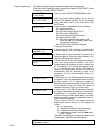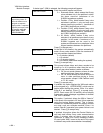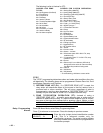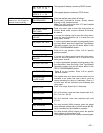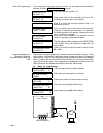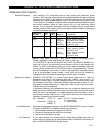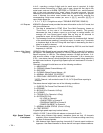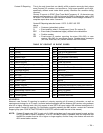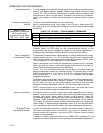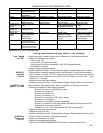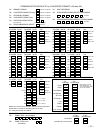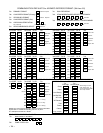
Ð 71 Ð
Section 5. SYSTEM COMMUNICATION
COMMUNICATION FORMATS
Split/Dual Reporting Dual reporting (*51) sends all reports to both primary and secondary phone
numbers. Split reporting allows reports to be divided between the phone numbers
according to the field's (1*34) selections. Split/Dual reporting can be selected by
enabling dual reporting and enabling one of the split reporting options in field
1*34. If option [1] is selected, all alarms, alarm restores and cancel reports will go to
both phone numbers, while all other reports will go to the secondary phone
number. If [2] is selected, open/close and test messages will go to both phone
numbers, while all other reports will go to the primary phone number. Following are
the Split/Dual Reporting options:
Reporting Field Number
Format *51 1*3 4 Phone # Reports
Dual 1 0 - - - - - - - - All reports to both numbers
Split 0 1 Primary alarms, restores, cancel
Secondary open/close, test
, troubles
0 2 Primary alarms, restores, troubles
Secondary open/close, test
Split/Dual 1 1 Primary alarm, restores & cancel
Secondary alarms, restores, troubles,
open/close, test
1 2 Primary alarms, restores, troubles
Secondary alarms, restores,
open/close, test
NOTE: 2-way audio test (code + #65) always routes to the primary phone
number regardless of the programming of fields *51 and 1*34.
If in DUAL/SPLIT reporting mode and 2-way AUTO CALLBACK is disabled, the
report will not go to the secondary phone number until the 2-way session has
ended. To allow the secondary phone to receive reports immediately after the
primary phone, enable AUTO CALLBACK mode in VIM programming. This will
prevent the sending of the Òlisten in to followÓ message (606), allowing the report
to go to the secondary phone number. 2-way voice can then be initiated by
calling back within 5 minutes and entering the correct audio ID number.
Ademco Low Speed ADEMCO LOW SPEED is a pulsed format which responds to a 1400 Hz
handshake and kiss-off, and transmits data with 1900Hz pulse tones @ 10
pulses per second (pps). A typical message consists of two rounds which must
be verified by the receiver. A complete standard report consists of either a 3 or 4-
digit account number followed by a 1-digit alarm code. Though 2 rounds are sent,
only the valid report is displayed.
In expanded reporting, two messages are sent, two rounds per message, the first
being the account number and alarm code, the second being the zone ID code to
which the alarm was assigned. A complete expanded report consists of a 3 or 4-
digit account number followed by a 1-digit alarm code, then the alarm code is
repeated, followed by the channel number.
EX. Standard: CCC(C) E where: CCC(C) = account number
E = event code
Expanded: CCC(C) E Z = zone ID code
EEE(E) Z
Sescoa/Radionics Standard and expanded reporting in the SESCOA/RADIONICS format is virtually
the same as ADEMCO Low Speed except for the following:
1. The handshake and kiss-off frequency is 2300 Hz.
2. The data is transmitted with 1800 Hz pulse tones.
3. The rate of transmission is 20 pps.
4+2 Reporting A 4+2 report consists of a 4-digit account number and a 2-digit alarm code, or
event code. 4+2 reports can be accomplished either in ADEMCO Low Speed (10
pps), or SESCOA/RADIONICS (20 pps) format.



